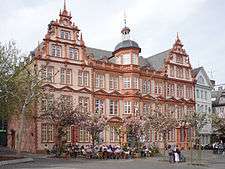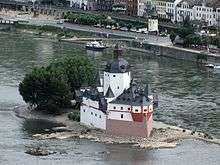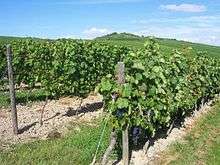Rhineland-Palatinate
Rhineland-Palatinate (German: Rheinland-Pfalz) is a state of Germany. The largest wine producing area in Germany, it is home to 6 of the 9 wine-producing districts in Germany and is full of museums, exhibitions and castles.
Regions
Rheinland-Pfalz is a region of rolling hills cut by deep river valleys.

| Eifel (Rhineland-Palatinate) Volcanic landscapes and blue crater lakes makes the Eifel region a special experience. |
| Hunsrück Follow the footsteps of the Romans and the Celts, explore their ancient settlement sites in the hills. |
| Middle Rhine Valley A famously scenic section of the Rhine, much of it a UNESCO World Heritage Site. |
| Moselle Valley The Moselle glides peacefully through the Moselle Valley, decorated with castles and romantic wine villages on its way. |
| Naheland The Naheland has been blessed with natural riches. The river Nahe passes a region whose fruity, aromatic wines fascinate lovers of the grape. |
| Palatinate The weather treats this region particularly well, and pink almond blossom appears every spring to please the senses. |
| Rhenish Hesse Germany's largest wine-making region with urban cities like Mainz and Worms within its borders, in addition to Mediterranean-like wine villages. |
| North-East Rhineland-Palatinate Includes part of Lahn Valley and the Westerwald east of the Middle Rhine Valley and north of the Taunus. A great region for hikers. |
Cities

- 🌍 Mainz — founded by the Romans and their legacy is still visible in many places around the town; also the home of Gutenberg, the inventor of the printing press, who also has his own museum in the city.
- 🌍 Cochem — on the Moselle
- 🌍 Koblenz — famous for the "German Corner" (Deutsches Eck), the meeting-point of the two rivers Rhine and Moselle; besides various churches and museums, the highlight-event every year is the "Rhine in flames", spectacular fireworks that fill the sky with beautiful colors
- 🌍 Landau in der Pfalz — a charming historic city on the German Wine Route
- 🌍 Neustadt an der Weinstraße — is situated in the heart of the Palatinate region, including a number of vineyards, castles and the chance to taste some really good wine
- 🌍 Speyer — largest Romanesque cathedral in the world, UNESCO World Heritage Site since 1980; you'll also find the Historical Museum and the Museum of Technology
- 🌍 St. Goar — in the Middle Rhine Valley near the Loreley
- 🌍 Trier — in Roman times Trier had thermal baths, places of assembly and an amphitheatre; today the colossal Porta Nigra town gate, the imperial baths and the impressive basilica keep that history alive
- 🌍 Worms — the annual host of the "Backfischfest", Rhineland-Palatinate's biggest wine festival and fair; it attracts hundreds of thousands of visitors to the city
Other destinations
- 🌍 Dernau
- 🌍 Ingelheim includes the Kaiserpfalz 8th century ruins of one of Charlemagne's palaces.
- 🌍 Bad Neuenahr-Ahrweiler
- 🌍 Nürburgring
- 🌍 Taunus
Get in
By plane
Rhineland-Palatinate has only one airport with scheduled passenger flights, in Hahn. Branded Frankfurt-Hahn Airport (HHN IATA) it is used by low-fare carriers as an alternative to major airports in West Germany. The airport is, however, nowhere near Frankfurt but rather deep in Hunsrück. Public transport operators from major cities in Rhineland-Palatinate offer direct bus shuttles to the airport. Unlike most other German airports it has no rail or rapid transit connection of any kind (as of 2015). Plans to build a rail connection have been announced but whether they will ever come to fruition remains to be seen.
The actual Frankfurt Airport is in the neighbouring Land of Hesse and is Germany's busiest airport with connections all over Europe and the entire world. Direct high-speed and local trains connect the airport to Mainz and Koblenz, where you can change to regional trains and buses to further destinations. Mainz and Koblenz are also served by direct hourly regional trains from Cologne-Bonn Airport (CGN IATA) and Düsseldorf Airport (DUS IATA). Some high-speed ICE trains to Koblenz and Mainz also stop at DUS.
By train
If traveling into Germany by train, Rhineland-Palatinate is easily accessible from Cologne, Frankfurt, Munich and Stuttgart.
By boat
The river Rhine has been a key factor in the history of the region and now a major tourist attraction. The Rhine together with the Main and Danube (connected by a canal through Franconia and Bavaria) provides a navigable route from the North Sea, Rotterdam to Basel, and Budapest and on to the Black Sea. The Moselle (German name: Mosel) also provides a winding route into France. Cruise companies such as Avalon and Viking provide trips into an through the region.
By bus
You can get a domestic bus from or to almost any place. Expect nothing fancy, though as the station infrastructure is still very limited.
Get around
The region has very good connections by train or bus, and all destinations and attractions are easily reachable. Koblenz, Ludwigshafen, Kaiserslautern, Speyer and the other romantic cities are easy to reach via train, and in the cities you can also move forewards with a bicycle, which is often as rental-bike available. You can also cruise up or down the Rhine between Koblenz and Mainz; see Rhine Valley for details. A boat trip that will be a memorable experience forever. Several car-rental opportunities are to be found in the region, also a practical possibility to get around easily.
Some good offers to explore the surroundings include the Rheinland-Pfalz-Ticket, offering unlimited travel in local trains for up to 5 persons inside the states of Rhineland-Palatinate, Saarland and Wiesbaden. The ticket costs €24 - 44 per day (as of Dec 2015) if bought via automat or internet, or €26 - 46 if bought at a ticket stand and is available at all train stations.
See


The Palatinate Forest is the biggest coherent forest in middle Europe; it is a biospehere reserve.
The Speyer Cathedral is the biggest romanuesque church worldwide; its foundation stone was laid in 1030. It is the resting place of 7 Salian emperors.
The Palatinate Forest hides over 50 castles and ruins that were mostly destroyed in the War of the Grand Alliance, for example:
- Castle Trifels near Landau in der Pfalz - Castle where Richard Lionheart of England was held as a hostage and the place where the imperial regalia was stored.
- Limburg Monastery near Bad Dürkheim
- Castle Lindenbrunn Landau in der Pfalz
- Castle Berwartstein near Bad Bergzabern
The Middle Rhine Valley has a continuous stream of castles including
- Rheinstein Castle near Trechtingshausen
- Rheinfels Fortress (Festung Rheinfels) St. Goar
- Pfalzgrafenstein Castle (Burg Pfalzgrafenstein). 14th-century toll station in the middle of the river Rhine. Reachable by boat from Kaub
In the Moselle Valley region
- Burg Eltz near Treis-Karden
There are a number of museums worth a visit, of note:
- Gutenberg Museum in Mainz
- German mineral museum in Idar-Oberstein
- Technical museum in Speyer
- Rhineland-Palatinate Open-Air Museum, collection of historic regional buildings near Bad Sobernheim.
Do
The Rhineland-Palatinate region is ideal for outdoor activities like Hiking, Biking, Golf, Nordic Walking, Camping or whatever the heart desires. An important history gives the chance to experience old times, through a range of museums, castles, churches and different exhibitions. There are also the possibility to sleep over in old castles, and live the life of the old empires.
Events
Special Events like for instance Rhine in flames, wine festivals, Christmas markets and concerts are also to be mentioned.
Itineraries
- The German Wine Route is the oldest wine route worldwide; it runs through the biggest wine growing area in Germany, the Palatinate. The western side is protected by the Palatinate Forest, on the eastern side lies the Rhine rift.
- The Rheinburgenweg provides an extensive hike passed many castles.
Drink

The wine regions of Ahr, Pfalz, Mosel and Rheinhessen are within the state providing plenty of opportunities for tasting. There are also a number of brewries in the region, probably the most well known being Bitburger.
Go next
As well as adjoining the German states of North Rhine-Westphalia, Hesse, Saarland and Baden-Württemberg it also borders the Liège (province) of Belgium, Luxembourg and the Lorraine region of France.